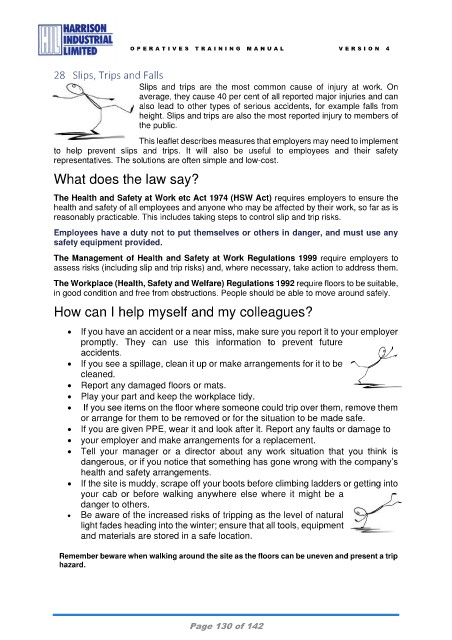Page 131 - HIL Operatives Training Manual V4 16022024_Neat
P. 131
O P E R A T I V E S T R A I N I N G M A N U A L V E R S I O N 4
28 Slips, Trips and Falls
Slips and trips are the most common cause of injury at work. On
average, they cause 40 per cent of all reported major injuries and can
also lead to other types of serious accidents, for example falls from
height. Slips and trips are also the most reported injury to members of
the public.
This leaflet describes measures that employers may need to implement
to help prevent slips and trips. It will also be useful to employees and their safety
representatives. The solutions are often simple and low-cost.
What does the law say?
The Health and Safety at Work etc Act 1974 (HSW Act) requires employers to ensure the
health and safety of all employees and anyone who may be affected by their work, so far as is
reasonably practicable. This includes taking steps to control slip and trip risks.
Employees have a duty not to put themselves or others in danger, and must use any
safety equipment provided.
The Management of Health and Safety at Work Regulations 1999 require employers to
assess risks (including slip and trip risks) and, where necessary, take action to address them.
The Workplace (Health, Safety and Welfare) Regulations 1992 require floors to be suitable,
in good condition and free from obstructions. People should be able to move around safely.
How can I help myself and my colleagues?
• If you have an accident or a near miss, make sure you report it to your employer
promptly. They can use this information to prevent future
accidents.
• If you see a spillage, clean it up or make arrangements for it to be
cleaned.
• Report any damaged floors or mats.
• Play your part and keep the workplace tidy.
• If you see items on the floor where someone could trip over them, remove them
or arrange for them to be removed or for the situation to be made safe.
• If you are given PPE, wear it and look after it. Report any faults or damage to
• your employer and make arrangements for a replacement.
• Tell your manager or a director about any work situation that you think is
dangerous, or if you notice that something has gone wrong with the company’s
health and safety arrangements.
• If the site is muddy, scrape off your boots before climbing ladders or getting into
your cab or before walking anywhere else where it might be a
danger to others.
• Be aware of the increased risks of tripping as the level of natural
light fades heading into the winter; ensure that all tools, equipment
and materials are stored in a safe location.
Remember beware when walking around the site as the floors can be uneven and present a trip
hazard.
Page 130 of 142

